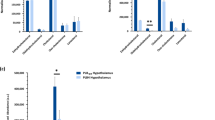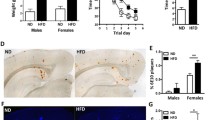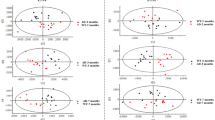Abstract
Lipids constitute almost 60% of the brain’s dry weight, and they are thought to be involved in inflammation, neurotransmission and synaptic plasticity. The brain mostly contains sphingolipids, glycerophospholipids and cholesterol which are abundant in myelin and neuronal membranes. The recent rise of the promising area of lipidomic data can be used as a diagnosing tool at the early stages of Alzheimer’s disease allowing novel therapeutic targets. In this review, altered lipid metabolites as well as the impact of diet in the progress of Alzheimer’s disease (AD) are analyzed.
Access this chapter
Tax calculation will be finalised at checkout
Purchases are for personal use only
Similar content being viewed by others
References
Anstey KJ, Lipnicki DM, Low LF (2008) Cholesterol as a risk factor for dementia and cognitive decline: a systematic review of prospective studies with meta-analysis. Am J Geriatr Psychiatry 16(5):343–354
Astarita G, Piomelli D (2011) Lipidomics of Alzheimer’s disease: a liver peroxisomal dysfunction in the metabolism of omega-3 fatty acids. OCL 18(4):218–223
Bascoul-Colombo C, Guschina IA, Maskrey BH, Good M, O’Donnell VB, Harwood JL (2016) Dietary DHA supplementation causes selective changes in phospholipids from different brain regions in both wild type mice and the Tg2576 mouse model of Alzheimer’s disease. Biochimica et Biophysica Acta (BBA)-Molecular and Cell Biology of Lipids 1861(6):524–537
Bazan NG, Colangelo V, Lukiw WJ (2002) Prostaglandins and other lipid mediators in Alzheimer’s disease. Prostaglandins Other Lipid Mediat 68:197–210
Belayev L, Mukherjee PK, Balaszczuk V, Calandria JM, Obenaus A, Khoutorova L, Bazan NG (2017) Neuroprotectin D1 upregulates Iduna expression and provides protection in cellular uncompensated oxidative stress and in experimental ischemic stroke. Cell Death Differ 24(6):1091
Bergstrom S, Ryhage R, Samuelsson B, Sjovall J (1962) The structure of prostaglandin E, F1 and F2. Acta Chem Scand 16(2):501–502
Calder PC (1998) Immunoregulatory and anti-inflammatory effects of n-3 polyunsaturated fatty acids. Braz J Med Biol Res 31(4):467–490
Calon F, Lim GP, Morihara T, Yang F, Ubeda O, Salem N et al (2005) Dietary n-3 polyunsaturated fatty acid depletion activates caspases and decreases NMDA receptors in the brain of a transgenic mouse model of Alzheimer’s disease. Eur J Neurosci 22(3):617–626
Carvey PM, Hendey B, Monahan AJ (2009) The blood–brain barrier in neurodegenerative disease: a rhetorical perspective. J Neurochem 111(2):291–314
Chen X, Wagener JF, Morgan DH, Hui L, Ghribi O, Geiger JD (2010) Endolysosome mechanisms associated with Alzheimer’s disease-like pathology in rabbits ingesting cholesterol-enriched diet. J Alzheimers Dis 22(4):1289–1303
Combrinck M, Williams J, De Berardinis MA, Warden D, Puopolo M, Smith AD, Minghetti L (2006) Levels of CSF prostaglandin E2, cognitive decline, and survival in Alzheimer’s disease. J Neurol Neurosurg Psychiatry 77:85–88. https://doi.org/10.1136/jnnp.2005.063131
Corsinovi L, Biasi F, Poli G, Leonarduzzi G, Isaia G (2011) Dietary lipids and their oxidized products in Alzheimer’s disease. Mol Nutr Food Res 55(S2):S161–S172
De Roos B, Mavrommatis Y, Brouwer IA (2009) Long-chain n-3 polyunsaturated fatty acids: new insights into mechanisms relating to inflammation and coronary heart disease. Br J Pharmacol 158:413–428
Giles C, Takechi R, Mellett NA, Meikle PJ, Dhaliwal S, Mamo JC (2016) The effects of long-term saturated fat enriched diets on the brain lipidome. PLoS One 11(12):e0166964
Gupta S, Knight AG, Gupta S, Keller JN, Bruce-Keller AJ (2012) Saturated long-chain fatty acids activate inflammatory signaling in astrocytes. J Neurochem 120(6):1060–1071
Han X, M Holtzman D, W McKeel D, Kelley J, Morris JC (2002) Substantial sulfatide deficiency and ceramide elevation in very early Alzheimer’s disease: potential role in disease pathogenesis. J Neurochem 82(4):809–818
Han X, Rozen S, Boyle SH, Hellegers C, Cheng H, Burke JR et al (2011) Metabolomics in early Alzheimer’s disease: identification of altered plasma sphingolipidome using shotgun lipidomics. PLoS One 6(7):e21643
Karmi A, Iozzo P, Viljanen A, Hirvonen J, Fielding BA, Virtanen K et al (2010) Increased brain fatty acid uptake in metabolic syndrome. Diabetes 59(9):2171–2177
Kolsch H, Heun R, Kerksiek A, Von Bergmann K, Maier W, Lutjohann D (2004) Altered levels of plasma 24S-and 27-hydroxycholesterol in demented patients. Neurosci Lett 368(3):303–308
Ledesma MD, Dotti CG (2006) Amyloid excess in Alzheimer’s disease: what is cholesterol to be blamed for? FEBS Lett 580(23):5525–5532
Logan AC (2004) Omega-3 fatty acids and major depression: a primer for the mental health professional. Lipids Health Dis 3(1):25
Lukiw WJ, Cui JG, Marcheselli VL, Bodker M, Botkjaer A, Gotlinger K, Serhan CN, Bazan NG (2005) A role for docosahexaenoic acid-derived neuroprotectin D1 in neural cell survival and Alzheimer disease. J Clin Invest 115(10):2774–2783
Lütjohann D, Papassotiropoulos A, Björkhem I, Locatelli S, Bagli M, Oehring RD, Schlegel U, Jessen F, Rao ML, von Bergmann K, Heun R (2000) Plasma 24S-hydroxycholesterol (cerebrosterol) is increased in Alzheimer and vascular demented patients. J Lipid Res 41(2):195–198
Mapstone M, Cheema AK, Fiandaca MS, Zhong X, Mhyre TR, MacArthur LH et al (2014) Plasma phospholipids identify antecedent memory impairment in older adults. Nat Med 20(4):415
Mielke MM, Bandaru VVR, Haughey NJ, Rabins PV, Lyketsos CG, Carlson MC (2010) Serum sphingomyelins and ceramides are early predictors of memory impairment. Neurobiol Aging 31(1):17–24
Muskiet FA, van Goor SA, Kuipers RS, Velzing-Aarts FV, Smit EN, Bouwstra H et al (2006) Long-chain polyunsaturated fatty acids in maternal and infant nutrition. Prostaglandins Leukot Essent Fat Acids 75(3):135–144
Nys M, Debruyne I (2011) Lipids & Brain 2: a symposium on lipids and brain health. Inform 11:397–399
Oksman M, Iivonen H, Hogyes E, Amtul Z, Penke B, Leenders I et al (2006) Impact of different saturated fatty acid, polyunsaturated fatty acid and cholesterol containing diets on beta-amyloid accumulation in APP/PS1 transgenic mice. Neurobiol Dis 23(3):563–572
Olazarán J, Gil-de-Gómez L, Rodríguez-Martín A, Valentí-Soler M, Frades-Payo B, Marín-Muñoz J, Antúnez C, Frank-García A, Jiménez CA, Gracia LM, Torregrossa RP, Guisasola MC, Bermejo-Pareja F, Sánchez-Ferro Á, Pérez-Martínez DA, Palomo SM, Farquhar R, Rábano A, Calero M (2015) A blood-based, 7-metabolite signature for the early diagnosis of Alzheimer’s disease. J Alzheimers Dis 45:1157–1173
Papassotiropoulos A, Lütjohann D, Bagli M, Locatelli S, Jessen F, Buschfort R, Ptok U, Björkhem I, von Bergmann K, Heun R (2002) 24S-hydroxycholesterol in cerebrospinal fluid is elevated in early stages of dementia. J Psychiatr Res 36(1):27–32
Pettegrew JW, Panchalingam K, Hamilton RL, McClure RJ (2001) Brain membrane phospholipid alterations in Alzheimer’s disease. Neurochem Res 26(7):771–782
Prasad MR, Lovell MA, Yatin M, Dhillon H, Markesbery WR (1998) Regional membrane phospholipid alterations in Alzheimer’s disease. Neurochem Res 23(1):81–88
Pratico D, Clark CM, Liun F, Lee VYM, Trojanowski JQ (2002) Increase of brain oxidative stress in mild cognitive impairment: a possible predictor of Alzheimer disease. Arch Neurol 59(6):972–976
Proitsi P, Kim M, Whiley L, Pritchard M, Leung R, Soininen H, Kloszewska I, Mecocci P, Tsolaki M, Vellas B, Sham P, Lovestone S, Powell JF, Dobson RJ, Legido-Quigley C (2015) Plasma lipidomics analysis finds long chain cholesteryl esters to be associated with Alzheimer’s disease. Transl Psychiatry 5:e494
Quehenberger O, Dennis EA (2011) The human plasma lipidome. N Engl J Med 365(19):1812–1823
Refolo LM, Pappolla MA, Malester B, LaFrancois J, Bryant-Thomas T, Wang R et al (2000) Hypercholesterolemia accelerates the Alzheimer’s amyloid pathology in a transgenic mouse model. Neurobiol Dis 7(4):321–331
Sato Y, Suzuki I, Nakamura T, Bernier F, Aoshima K, Oda Y (2012) Identification of a new plasma biomarker of Alzheimer’s disease using metabolomics technology. J Lipid Res 53(3):567–576
Shevchenko A, Simons K (2010) Lipidomics: coming to grips with lipid diversity. Nat Rev Mol Cell Biol 11(8):593
Stranahan AM, Cutler RG, Button C, Telljohann R, Mattson MP (2011) Diet-induced elevations in serum cholesterol are associated with alterations in hippocampal lipid metabolism and increased oxidative stress. J Neurochem 118(4):611–615
Stryer L (1988) Biochemistry. In: Biosynthesis of membrane lipids and steroid hormones. W.H. Freeman and Company, New York, pp 552–553
Tajima Y, Ishikawa M, Maekawa K, Murayama M, Senoo Y, Nishimaki-Mogami T, Okuno A (2013) Lipidomic analysis of brain tissues and plasma in a mouse model expressing mutated human amyloid precursor protein/tau for Alzheimer’s disease. Lipids Health Dis 12(1):68
Trushina E, Dutta T, Persson XMT, Mielke MM, Petersen RC (2013) Identification of altered metabolic pathways in plasma and CSF in mild cognitive impairment and Alzheimer’s disease using metabolomics. PLoS One 8(5):e63644
Wang Z, Liu D, Wang F, Liu S, Zhao S, Ling EA, Hao A (2012) Saturated fatty acids activate microglia via Toll-like receptor 4/NF-κB signalling. Br J Nutr 107(2):229–241
Whelan J (2008) (n-6) and (n-3) Polyunsaturated fatty acids and the aging brain: food for thought. J Nutr 138(12):2521–2522
Wishart DS, Feunang YD, Marcu A, Guo AC, Liang K et al (2018) HMDB 4.0: the human metabolome database for 2018. Nucleic Acids Res 46(D1):D608–D617. 29140435
Wisniewski T, Newman K, Javitt NB (2013) Alzheimer’s disease: brain desmosterol levels. J Alzheimers Dis 33(3):881–888
Wong MW, Braidy N, Poljak A, Pickford R, Thambisetty M, Sachdev PS (2017) Dysregulation of lipids in Alzheimer’s disease and their role as potential biomarkers. Alzheimers Dement 13(7):810–827
Author information
Authors and Affiliations
Corresponding author
Editor information
Editors and Affiliations
Rights and permissions
Copyright information
© 2020 Springer Nature Switzerland AG
About this paper
Cite this paper
Kalli, E. (2020). Nutritional Lipidomics in Alzheimer’s Disease. In: Vlamos, P. (eds) GeNeDis 2018. Advances in Experimental Medicine and Biology, vol 1195. Springer, Cham. https://doi.org/10.1007/978-3-030-32633-3_14
Download citation
DOI: https://doi.org/10.1007/978-3-030-32633-3_14
Published:
Publisher Name: Springer, Cham
Print ISBN: 978-3-030-32632-6
Online ISBN: 978-3-030-32633-3
eBook Packages: Biomedical and Life SciencesBiomedical and Life Sciences (R0)




